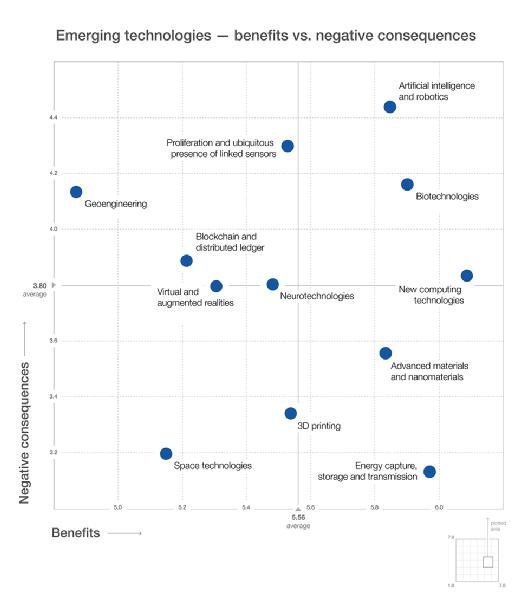
Fotimmz - Fotolia
Davos: Technology poses new risks to jobs, economies and society
Politicians and business leaders will discuss the risks posed by technology to jobs, political stability and cyber security at the World Economic Forum in Davos
Rapid advances in technology could have destabilising effects on employment and economic growth, and could exacerbate social unrest, the World Economic Forum (WEF) warned this week.
Society’s failure to keep pace with technology change will be one of the key risks under discussion as business leaders, politicians, academics and non-government organisations assemble in Davos, Switzerland, from 17 to 20 January.
The expansion of artificial intelligence (AI) is likely to destroy traditional white-collar jobs at a faster rate than new jobs are created, unless governments and the private sector collaborate to manage the problem, a report published in advance of the summit reveals.
The WEF’s Global Risks 2017 report warns that, as a result of AI and other disruptive technologies, long-term jobs are giving way to self-employment in the “gig” economy, leaving individuals to shoulder more responsibility for the costs of unemployment, sickness and old age.
Technology disruption, more than globalisation, deteriorating job prospects and industrial decline, has been the catalyst for anti-establishment voting, which led to Brexit in the UK, the election of Donald Trump in the US, and Italy’s rejection of its former prime minister’s constitutional reforms, the report claims.
Unless there is a concerted effort from governments and the private sector, the trend will put pressure on economies and may lead to social unrest, said Cecilia Reyes, chief risk officer of Zurich Insurance Group.
“Without proper governance and reskilling of workers, technology will eliminate jobs faster than it creates them,” she said. “Governments can no longer provide historic levels of social protection, and an ant-establishment narrative has gained traction, with new political leaders blaming globalisation for society’s challenges.”
Emerging technologies
The WEF has identified 12 emerging technologies that have the potential to change the nature of society, work and politics. They include blockchain technology, which underpins crypto-currencies such as bitcoin, 3D printing, nano materials, the internet of things, quantum computing and virtual reality.
The report argues that the benefits of these technologies will outweigh the risks, but they will pose difficult questions for regulators and politicians.
Investors will be reluctant to back the development of technologies that they fear may later be banned or shunned if the absence of effective governance leads to a loss of public confidence.
Self-driving vehicles will inevitably cause accidents, but whether this leads to calls for bans will depend on whether people trust the mechanisms set up to regulate their development.

“Self-driving vehicles offer tremendous opportunities for improving safety,” said Richard Samans, member of the managing board at the WEF. “In the US, there were 40,000 [road] fatalities. SDVs could cut that to 20,000. Do you expect 20,000 thank-you letters or 20,000 law suits?”
One of the challenges for regulators is that businesses tend to innovate first and worry about the potential risks of technology afterwards, said John Drzik, president of global risk at insurer Marsh, one of the contributors to the report.
“There is a lack of governance with emerging technologies in variety of spheres – biotechnology is one, AI, the internet of things. The things that are newer are usually the ones where the risk management is misdeveloped,” he said in an interview with Computer Weekly.
Growth of cyber risks
The internet of things – the rapidly expanding network of household appliances, sensors and industrial equipment communicating over the internet – is creating new cyber risks that could allow hackers or nation states to attack physical infrastructure, said Drzik.
“A household provides a smart thermometer, for example. What becomes clear to people is the convenience of putting these devices and a lot of your household appliances onto the internet and to control it all together. It seems quite positive and a convenience. What becomes less obvious is the exposure you have now created.
“We tend to deal with the risk after the innovation has been installed. To date, we have not had a catastrophic event in that regard, but there [adverse] things that could happen.”
Impact of technology on jobs
One of the most difficult challenges for businesses and governments will be managing the impact of robotics and AI on jobs.
Estimates vary hugely, but a report by McKinsey in 2015, quoted by the WEF, found that 45% of the activities that workers do today could be automated if companies want to do so.
Mining company RioTinto, for example, is using self-driving trucks, some of which are being controlled from a distance of 750 miles.
Threat to white-collar jobs
In the past, robotics reduced the number of blue-collar jobs, but today, AI technologies could eliminate swathes of office jobs, said Drzik.
“AI is going to focus now as much on white-collar as on blue-collar jobs. You are looking at machine learning algorithms being deployed in financial services, in healthcare and in other places. The machines are getting increasingly powerful.”
Although, historically, technology has increased labour productivity and created new and better jobs, as machines become more intelligent, there is significant uncertainty over future job creation.
The US manufacturing industry is producing as much as it ever did, but with fewer workers.
According to economists, 80% of the decline in the share of income going to the workforce between 1990 and 2007 resulted from improved technology.
This trend is expected to spread to the service sector, as rapid advances in robotics, sensors and machine learning enable employers to replace hired labour.
Much of the technology needed to replace white-collar jobs is already here, said Drzik.
“It will take a while for AI to penetrate fully, because companies in general are not ready to turn over their decision-making to black boxes without a substantial degree of testing and experimentation, but I think that is already taking place.”
Tech companies may attract protest
One concern is the impact of technology on jobs in areas of the world, including parts of Europe, where there are already high levels of unemployment. That could lead to political protests, with technology companies becoming a target, said Drzik.
“I think that is where you could have a lot of resistance to this, and that is why I think companies weighing the deployment of technology are going to have to weigh public and political acceptance of the deployment of technology,” he said.
Technology is fundamentally changing the way people work by making it easier to connect workers in one country with jobs in another, making it less clear which employment laws and taxes apply and weakening employment protection.
Governments therefore need to work out how best to support a growing number of “gig economy” workers who are being left out of existing welfare schemes, while ensuring that governments continue to receive tax income to support them, said the WEF.
The biggest global risks in 2017
Top five global trends
1 Rising income and wealth disparity
2 Changing climate
3 Increasing polarisation of societies
4 Rising cyber dependency
5 Ageing population
Top five most likely risks
1 Extreme weather events
2 Large-scale involuntary migration
3 Major natural disasters
4 Large-scale terrorist attacks
5 Massive data fraud or theft
Top five risks with biggest impact
1 Weapons of mass destruction
2 Extreme weather events
3 Water crises
4. Major natural disasters
5. Failure of climate change mitigation










